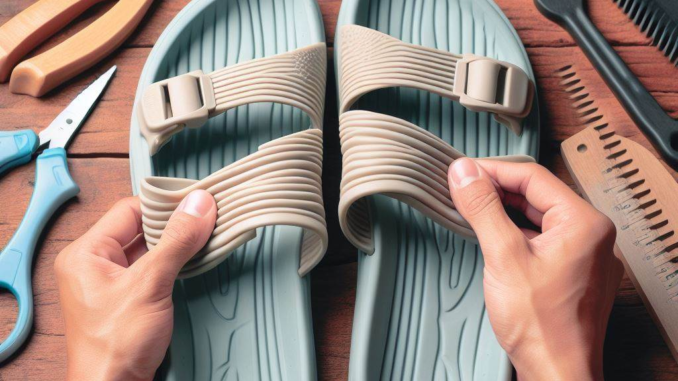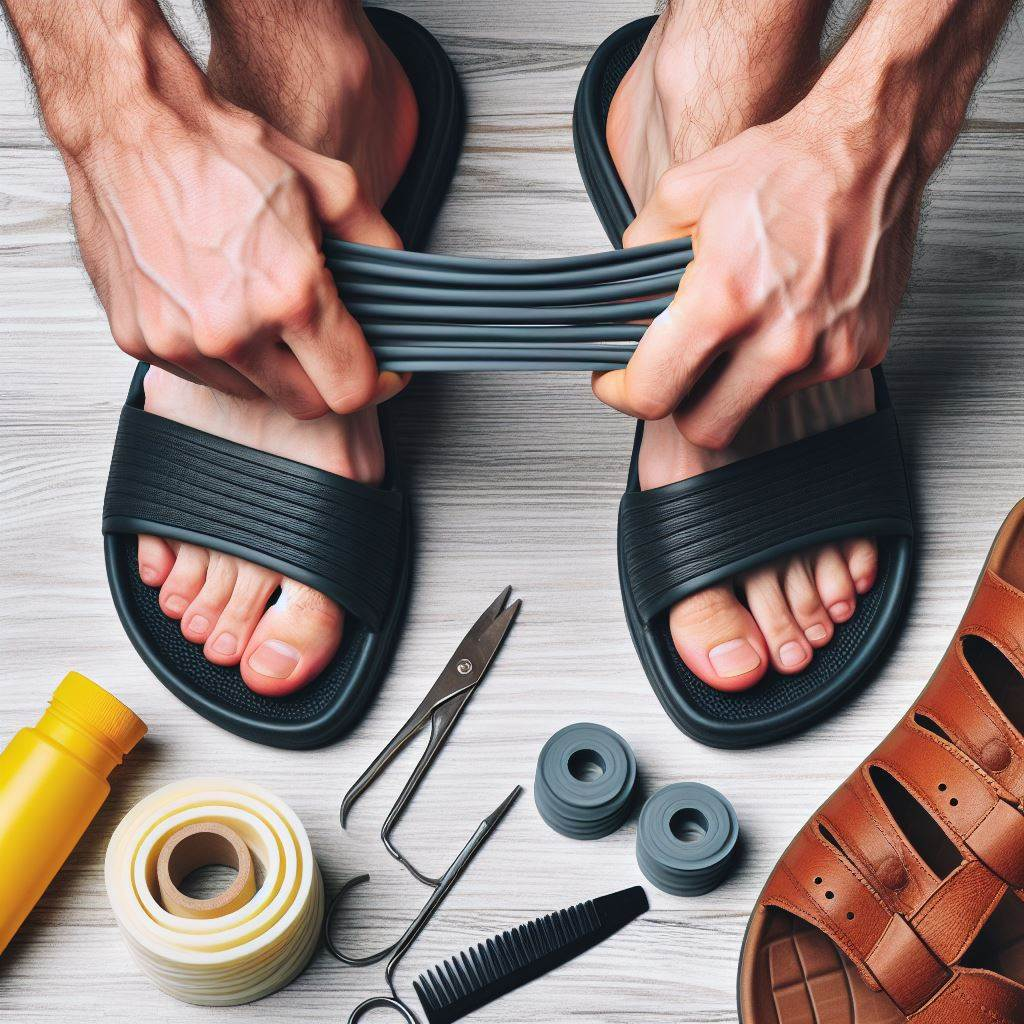
How to stretch rubber sandals for a Perfect Fit?
I often struggled with tight, uncomfortable rubber sandals that caused me foot pain and blisters. After facing this issue for years, I decided it was time to take action. That’s when I embarked on a mission to research and test methods for stretching rubber sandals to achieve the perfect, custom fit.
Why Proper Fit Matters to Me
From my experience, a comfortable fit is absolutely essential for sandals worn in warm weather for extended periods. My tight rubber sandals not only caused immediate discomfort when walking but led to ongoing foot problems over time. I knew a well-fitted sandal could make all the difference in enhancing my walking experience and preventing foot pain. Stretching my rubber sandals properly became a priority for me.
My Process for Stretching Sandals
I explored a wide variety of techniques to stretch my rubber sandals, ranging from manual methods using my hands to employing tools and devices designed specifically for the task. Each approach had its merits depending on the type and degree of tightness I was dealing with. I quickly realized patience and the right technique for rubber material were key.
What I Kept in Mind
- Take it slow: Rushing the stretching process could damage my sandals.
- Rubber reacts uniquely: It requires different techniques than other footwear materials.
- Comfort is the goal: Getting a perfect fit without compromising the sandal was my focus.
Key Takeaways from My Journey
- Stretching improved comfort tremendously: My properly stretched sandals were so much better for walking.
- I had to tailor techniques to rubber: Methods that worked for other materials weren’t always suitable.
- Patience and care were crucial: I got the best results by being gentle and persistent.
Considering My Sandals’ Rubber Material

I did research first to understand the characteristics of my rubber sandals’ material. Rubber has unique properties compared to leather or synthetic materials when it comes to stretching. It has high elasticity but can be quite resistant to certain methods.
How Rubber Differs from Other Materials
From my research, I learned rubber offers excellent elasticity and flexibility but doesn’t react the same way to stretching as leather or fabric sandal materials. Keeping these differences in mind was important in choosing a technique that wouldn’t damage my rubber sandals.
Selecting the Right Method for Rubber
Understanding rubber’s specific properties told me which stretching methods would work best. I learned that heat can be very effective for rubber, whereas cold approaches may be better for materials like leather. This knowledge helped me pick the right techniques to safely stretch my rubber sandals.
What I Considered About Rubber
- Elasticity range: How far rubber can stretch without being damaged.
- Sensitivity to temperature: Heat works better than cold for rubber.
- Resilience: Rubber regains its shape after stretching.
Preparing My Sandals Before Stretching
Before attempting to stretch my sandals, I made sure to properly clean and inspect them. This let me identify specific tight spots to focus my efforts on for the most effective stretching.
Cleaning and Inspecting My Sandals
First, I gently cleaned my sandals with mild soap and water, drying them thoroughly after. During the inspection, I looked closely for areas of tightness and hardening. I knew these would need extra attention when stretching.
Locating the Tight Areas
Wearing the sandals helped reveal where the tightest spots were for me, like the toe box, straps, and heel section. I lightly marked these areas with chalk so I could be sure to target them for stretching.
My Preparation Steps
| Step | Action |
|---|---|
| 1 | Clean sandals and dry them fully. |
| 2 | Inspect and identify tight spots. |
| 3 | Mark tight areas to target. |
These preparatory steps ensured I could stretch my sandals effectively and safely, focusing on the specific areas that needed it most.
Manual Stretching Techniques I Used

I tried two popular manual stretching techniques requiring no special tools – just my own hands and patience.
Stretching with My Hands
One simple but effective method was using my hands to stretch. I grasped the sandal firmly in tight areas and pulled slowly but steadily to stretch the rubber. It took concentration to apply adequate force without causing damage.
What I Kept in Mind
- Target the tightest spots: I focused on the most uncomfortable areas.
- Take it slowly: I didn’t expect immediate results from manual stretching.
Wearing Thick Socks
I also had success manually stretching my sandals by wearing thick socks with them. The extra bulk helped expand the rubber material gradually as I walked around the house.
My Process for Thick Socks
| Step | Action |
|---|---|
| 1 | Put on thick socks. |
| 2 | Wear sandals over socks. |
| 3 | Walk around indoors. |
I liked this gentle manual technique since it didn’t require heat or devices. The results took time but the gradual stretching prevented damage.
Using Tools and Devices to Stretch
For a more targeted stretching approach, I incorporated tools designed specifically for expanding footwear. These offered efficient, precise stretching.
Shoe Stretchers
Shoe stretchers were incredibly helpful for stretching my sandals evenly. I inserted them into the tight areas, adjusted to the desired width, and left them in overnight. The stretchers expanded the rubber methodically.
Why I Liked Stretchers
- Even, controlled stretch: The stretchers expanded the sandals uniformly.
- Customizable: I could target specific spots and control the amount of stretch.
Freezer Method
I also used the freezer method, placing sealed bags of water in my sandals’ tight spots before freezing them. As the water froze and expanded, it stretched the rubber effectively.
My Process for the Freezer Method
| Step | Action |
|---|---|
| 1 | Fill bags with water. |
| 2 | Place in tight areas. |
| 3 | Freeze sandals overnight. |
| 4 | Remove frozen bags. |
These tool-based approaches offered helpful stretching capabilities. However, close monitoring was essential to avoid potential damage from overstretching.
Using Heat to Stretch My Sandals
I discovered heat was extremely effective for stretching my rubber sandals safely. It softened the rubber, making it easier to manipulate.
Stretching with a Hair Dryer
I used a hair dryer set on warm to heat my sandals before stretching. Positioning it about 6 inches away, I moved it continuously to avoid overheating any one area.
What I Was Careful About
- Prevent overheating: This could damage the rubber, so I kept the dryer moving.
- Stretch right after: For best results, I stretched immediately after warming the rubber.
Soaking in Warm Water
Soaking my sandals in warm water for 15-20 minutes also softened them up for stretching. After soaking, I either wore them with thick socks or used my hands to stretch further.
My Process for Soaking
| Step | Action |
|---|---|
| 1 | Fill the basin with warm water. |
| 2 | Soak sandals for 15-20 minutes. |
| 3 | Remove and stretch immediately. |
These heating techniques were incredibly helpful for targeted tight spots. I was careful not to overheat the rubber to avoid potential damage.
Maintaining the Stretch Over Time
After finally achieving my desired stretch, keeping my sandals fitting comfortably required ongoing care and maintenance.
Wearing Them Regularly
I made sure to wear my stretched sandals frequently, especially in the first few weeks. The movement and flexing helped keep the rubber supple so it didn’t shrink back down.
Storing Properly
How and where I stored my sandals also impacted their fit. I avoided hot spaces or cramped storage where they could become misshapen. Instead, I kept them in a cool, dry place laid flat.
My Storage Tips
- No direct sun: Heat can cause the rubber to lose stretch.
- Keep flat: This prevents distortion of the sandals.
With regular wear and proper storage methods, I was able to maintain the perfect amount of stretch for long-lasting comfort.
Troubleshooting Issues I Faced
Despite my best efforts, I ran into a couple of issues that required some creative troubleshooting.
Sandals Became Too Loose
When my stretching attempts went too far and the sandals became loose, I used insoles and heel grips. These helped fill excess space without compromising comfort.
How I Adjusted the Fit
- Insoles: Provided padding and snugness.
- Heel grips: Stopped my heels from slipping.
Uneven Stretching
If one sandal ended up fitting differently than the other, I focused extra stretching efforts on the tighter one. It took patience and multiple tries to get both sandals fitting evenly.
How I Corrected It
| Step | Action |
|---|---|
| 1 | Identify tighter sandals. |
| 2 | Target stretch-tight sandals. |
| 3 | Compare fit and adjust. |
Catching these issues early and making gentle corrections maintained the comfort I had achieved.
My Key Takeaways from Stretching Rubber Sandals
After researching, testing, and troubleshooting a variety of approaches, I found effective stretching methods that worked wonders for my rubber sandals. The results were a custom, comfortable fit that made my sandals an absolute joy to wear.
Most Effective Techniques I Discovered
For me, the best techniques included manual stretching, shoe stretchers for uniform expansion, and heat methods like warm water soaking. Combining approaches yielded the optimal amount of stretch.
Importance of Patience and Consistency
Above all else, having patience and persisting with the stretching process gently over time gave me the best outcomes. Rushing only risks damage, so the key is to go slowly and keep at it for permanent results.
I’m thrilled to now have rubber sandals that fit like a glove and no longer cause discomfort. With the right techniques tailored specifically to the material, rubber sandals can be stretched for the perfect fit.
The Journey Continues: Ongoing Care of My Stretched Sandals
Even after successfully stretching my rubber sandals to the perfect fit, I realized maintenance would be an ongoing process. The material could revert over time if I wasn’t diligent.
Being Aware of Factors that Impact Fit
Through trial and error, I learned certain factors can cause stretched sandals to shrink back down over time. Heat is a major element, as direct sunlight or hot storage conditions can make the rubber lose flexibility. Pressure and weight are also considerations since cramped spaces can compress the material.
What I Watch Out For
- Heat: Direct sun or hot storage can shrink the rubber.
- Pressure: Cramped storage spaces compress the shape.
- Weight: Heavy objects on sandals flatten them over time.
Proactively Maintaining Fit and Flexibility
Being proactive with my storage methods, wear habits, and general handling of the sandals helps me maintain the stretch I worked so hard to achieve. I’m careful to keep them away from direct heat, store them with space to breathe, and wear them regularly to keep the rubber flexible.
My Ongoing Maintenance
- Rotate sandals when wearing: This distributes stretch evenly.
- Wash gently: Using mild soap prevents shrinkage.
- Store properly: Laying flat in a cool, dry place is ideal.
With this regular care and maintenance, the fit and comfort I stretched my sandals to remain in perfect shape for the long run.
Helpful Tips I Share with Others
Based on my first-hand experience stretching rubber sandals, I’m happy to share advice with friends and family dealing with the same tight, uncomfortable fit.
Emphasizing Patience and Gradual Stretching
The number one tip I emphasize is having patience. Rushing the process through aggressive stretching can permanently damage the sandals. I advise going slowly with manual techniques first before considering tools or heat.
Importance of Material-Specific Methods
I also highlight that rubber requires different approaches than other materials. Methods that work wonders on leather may be ineffective or even damaging to rubber. Tailoring the techniques specifically to rubber material is key.
Proper Storage for Maintaining Stretch
Additionally, I share the storage tips that have worked so well for me, like keeping the sandals away from direct sun and avoiding cramped spaces where they can become misshapen. Proper storage preserves the stretch.
By passing on what I’ve learned, I hope I can spare others the discomfort and frustration I once felt from sandals that just didn’t fit right. With the right stretching methods and care, rubber sandals can become the comfiest footwear you own.
My Final Takeaways
At the end of my journey to stretch my painful rubber sandals, I walk away with invaluable knowledge that has restored my footwear comfort. The tips and techniques I’ve picked up can help anyone struggling with tight-fitting sandals.
Key Learnings
Most importantly, I learned that patience, the right methods for the specific material, and proper ongoing care are the keys to success. Rushing the process or using overly aggressive techniques only lead to damage.
Remembering the Reward
Whenever I wear my perfectly fitted sandals now, I remember how worth it the stretching process was. The comfort and ease I feel now were well worth the time and care I invested. I encourage anyone in discomfort to take control and stretch their sandals for the custom fit they deserve.
With some patience and persistence, stretched rubber sandals can become your most comfortable footwear for seasons to come. I hope my experience helps others find the joy I did in breaking in my beloved sandals just right.


Leave a Reply